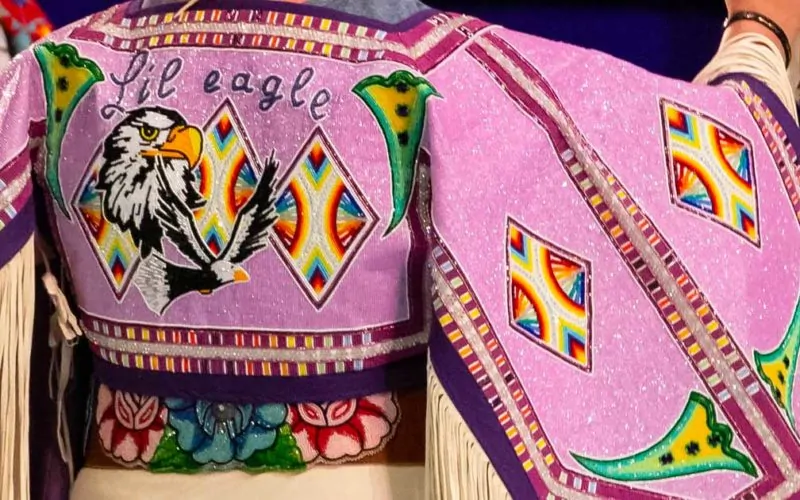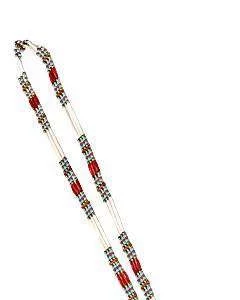One of the most common arts and crafts practiced by multiple Native American tribes included the decorative use of beads of various types. Generations before Europeans landed on the shores of the new world, Native American beadwork used primarily stone, shell, quills, and bone carved patiently with non-metal tools. As the decades went by and new materials like metal and glass were introduced by the new people arriving on the shores, the beadwork patterns used on clothing, jewelry, and decorations became much more intricate and stylized.
Many people now enjoy Native American beading designs mixed into their fashion sense or displayed on decorator items around their homes. While the beading techniques and styles have changed quite a lot over the centuries, Native American beaded patterns remain an important part of this decorative artwork.
In this post, we'll cover everything from types of Native American beading, seed beads, the role of the Plains Indian in the development of Native beadwork, and tons more!
The Importance of Native American Beadwork
Archeologists have found beads of varying materials, styles, and sizes in digs focused on various Native American settlements and tribes over the years. Originally, they may have been used as a type of currency for trades among tribes and individuals. Primarily, they simply decorated everything from buffalo hide belts to complex necklaces that featured story bead combinations. Unlike European artwork designed to stay in place and decorate a room, the nomadic nature of the Native Americans necessitated a combination of design and functionality. Their bead-based art existed in clothing, everyday objects, and their tents and horse tack.
One of the earliest forms includes porcupine quills stitched painstakingly onto Native American moccasins and robes. These natural items were easy to gather from hunted animals, could be cut to any length that suited the design, and already had a natural hole through the middle. Then, Native American beadwork continued when the people used stone tools or abrasive sand to shape other materials and drill holes through them. Semi-precious stones like turquoise and jasper were quite popular, especially in the southwestern section of the country. Those early years of wood, shell, and stone gave way quickly to the more colorful and flashy metal, ceramic or glass beads in silver and copper.
After the Europeans came, beadwork changed somewhat in both practice and value. The initial rarity of the bright glass beads made their worth skyrocket. Wampum, or shell beads threaded on a cord, were frequently used by both settlers and indigenous people until it became so commonplace that its value plummeted. Native American beaded patterns became a symbol of wealth, were used in marriage ceremonies, trade agreements, and treaties. Some beadwork patterns involve ritualistic use and were often used in spiritual dances and celebrations.
In these modern days, American Indian beading remains important for both the people themselves and as a cultural artifact that teaches all about an important part of history. From a purely decorative standpoint, many people from all cultures and traditions simply love the look of the unique Native American beaded designs associated with various indigenous peoples. Visitors can view exceptional pieces at history museums across the country. Fans can purchase authentically crafted jewelry and other accessories from shops both online and off. Many non-native people and companies also use the techniques and styles of the American Indian population's beading artwork to create new, modern beading designs or mimic older ones.
Native American Beading Styles
Most people understand American Indian beading as something that includes either stringing beads on threads to make jewelry or stitching beads directly onto a material backing. Some of the most impressive Native American techniques create large, flexible sheets or strips of beads tightly arranged in patterns or pictures.
Explore some of the most common Native American beadwork techniques and stitches, including those used by the Plains Indian, to learn more about how they are done and what they are used for.
Lazy or Lane Stitch
https://www.instagram.com/p/llIqWuBtIC/?utm_source=ig_web_copy_link
This Native American beadwork method works almost the same as the overlay stitching above, except the artist works in short lengths of beads and affixes them to the fabric only at the ends. This was frequently used for large patterns such as on moccasins or cradles that had large areas of one color. For example, to fill the yoke of a dress, the craftswoman would repeatedly stitch rows of six to eight beads in tight, neat lines until they got to the next color. Different Native American tribes used different numbers of beads. The Sioux, for one, used eight or nine in each small row.
In the area of the country that would become New England, the lazy stitch took on a unique ridged appearance through use of a different technique. The same number of beads were attached to a smaller section of fabric, which made them arc up away from the surface slightly. This added a three-dimensional component to Native American flat beadwork stitching, which works nicely for Native American jewelry.
Loom Beading
https://www.instagram.com/p/BuAV7yJnDLO/?utm_source=ig_web_copy_link
When Native American beading occurred without backing fabric or leather, the artists frequently used a type of loom to form long strips. These could be used for hair decorations, belts, or sewn together after completion to create a wider piece.
Although commercial beading looms exist today at any craft store, original Native American looms either used the beader's own body or wood bent similar to a bow to form the frame. Like weaving threads or yarn, the bead loom has warp string separated with a small divider on each end. Another thread or sinew forms the weft that is threaded on a needle. The artist puts the correct pattern of beads onto the needle, slides it down to the warp string, positions each bead between the warp, and then pushes the weft back through the beads on the opposite side to hold them in place.
Plains Indian artists used Native American beading looms more regularly. This increased in popularity during the 1800s and after the Civil War when more trade spread westward.
Gourd or Peyote Stitch
https://www.instagram.com/p/BuCTua3AQkc/?utm_source=ig_web_copy_link
Instead of using a loom or fabric backing for this type of Native American beadwork, gourd or peyote stitching is worked as a tube or directly around an object like the handle of a basket. Each pattern designed must include a total number of beads that divide evenly by three. This makes sense because, if you look at a finished piece or a pattern closely, you see that the horizontal lines going around the tube are really clusters of three beads in a miniature triangle.
Using tiny glass seed beads, you fill your thread with the beads to go around the pattern once, then add more as you slip the thread through the first beads in turn. This creates a type of net without spaces between it, but it's only made possible with the seed beads. Today, this Native American stitching is used extensively to make keychains, jewelry, necklaces, and similarly small accessories.
Brick Stitch
https://www.instagram.com/p/B0Wqs8AHYV9/?utm_source=ig_web_copy_link
A very similar Native American technique to the gourd stitching described above, the brick stitching does not require factors of three in the pattern making. Instead of creating it around a cylindrical object, it is frequently created to lie flat. Other names for it include Cheyenne, Comanche, and bugle stitch. To create a flat mat of beads in a particular design, they are arranged horizontally with the bead holes on either side instead of directly next to each other. This requires a sometimes tricky method of holding them in place while you make the stitches.
Thread a short stretch of beads on a needle, then push them down to the knot at the end. Use the same needle and thread to weave back through the opposite side hole on each bead until they line up like bricks. Complete each row before moving on to the one next to it. The separate rows are woven together by passing the thread through the end loop that feeds out of each hole. This Native American stitching can create any type of pattern or picture dreamed up, including on jewelry.
Beaded Applique
https://www.instagram.com/p/BtQ6vxPlTC1/?utm_source=ig_web_copy_link
Applique has been used in many cultures and time periods since the first time someone invented a needle. You can still find appliques of embroidered patches or fabric “stickers” that are sewn onto trendy jeans or jackets. When it comes to Native American beadwork techniques, beaded applique was used in much the same way. Instead of using overlaid or lane stitching to attach decorative patterns of beads directly to the fabric or leather, the artist created the design on another, a smaller piece that was then sewn onto the final form.
In some cases, strips or large patterns were created on bead looms and then sewn in place on a backing material. This applique technique would make decorative work much easier as the artist only had to work with a smaller item rather than an entire dress, tipi, or headdress.
Overlaid Stitch
This type of Native American Indian beadwork also goes by the names spot or crow stitching. It is a relatively common way to attach patterns of beads to fabric or leather. After the artist plans the patterns and where each color of the bead will go, they thread a needle with sinew or, in more modern circumstances, beading thread. The beads line the thread in the correct order so that, when laid across the fabric, they already form the pattern. For example, if the beader wanted to make simple stripes, they would thread three white beads, three blue beads, three white beads, etc.
After the thread contains all the necessary beads for the first part of the design, the artist lays it across the fabric. Then, they use another needle to stitch the first thread down to the fabric between each bead. This secures the pattern neatly.
Today, the popularity of Native American Indian beadwork design and handicrafts continues unabated. Although many people do not understand the historical significance, they still enjoy the look of the pieces. Although the 1990 Indian Arts and Crafts Act made it illegal for anyone other than an American Indian to claim to produce native beaded crafts, jewelry, or art of any kind, there are plenty of “native-inspired” products out there.
Although the Native American Indian beadwork techniques did not differ greatly between Native Amerian tribes due to their frequent trading and influence, there were preferences and regional differences that affected the type of beaded designs found from them.
For example, different Native American groups seemed to prefer different colors and traded with the Europeans specifically for those. The Sioux frequently worked on a white background and used bold blues, yellow, various shades of green, and a unique shade of pink. The Cheyenne shared the Sioux's love of background white but included more turquoise, transparent beads, and bright red in their patterns. Far northern groups like the Ojibwa had multi-colored backgrounds with dark red, crystal clear, and even black with many floral motifs. Southeastern tribes like the Cherokee used a lot more black in their beading than other Native American groups.
These differences may have reflected what each group valued in the world, or were simply personal preferences that became trends much like people today have favorite colors in fashion. No matter what colors they chose, the overwhelming styles and designs featured geometric shapes of various types.
These Native American beading methods have become popular among crafters from all ethnicities and walks of life. American Indians use peyote stitching to create US flag keychains, work out rainbow-hued beaded friendship bracelets on bead looms, and recreate everything from fine art to jewelry to cartoon characters on canvas with lane or overlay stitches.
From the rich tradition that began in pre-historic times, today's beading community finds methods, ideas, and inspiration aplenty from the Native American Indian beadwork masters.
References
1. https://www.kshs.org/kansapedia/native-american-beadwork/17880
2. http://indians.org/articles/beads.html
3. http://www.prairiefirenewspaper.com/2009/07/the-history-and-artistry-of-plains-indian-beadwork
4. http://www.nativetech.org/beadwork/beadwork.html
5. https://www.kshs.org/kansapedia/native-american-beadwork/17880
6. http://www.native-american-beadwork.net/english/English04Stitches_Lane.htm
7. https://www.kshs.org/kansapedia/native-american-beadwork/17880
8. http://www.nativetech.org/beadweav/bweavt7.html
9. https://anthromuseum.missouri.edu/exhibit/loom-beadwork-plains-indians
10. https://www.trc-leiden.nl/trc-needles/techniques/beadworking/peyote-stitch
11. https://beadage.net/glossary/brick-stitch/
12. https://www.crazycrow.com/site/native-american-tribal-bead-color-preference/
Countdown to Gathering Giveaway
Bonus Code – 273303
Last Updated on March 27, 2024 by Paul G





Patricia Beavers
says:I have a question about beadwork. I am researching a beaded Headband. It was found in a jewelry box after someone passed away. I do not know the origin or age of the piece. Person that I am trying help find answers is the grandson of the person who had it in the jewelry box. The design is basic triangles. The main beading is comprised of silver lined clear beads. I am wondering when is type of bead started being used or any historical info on this process. Any help would be appreciated.
Thank You
Patricia Beavers
Joerg Ringe
says:Hi there,
thank you for the interesting information above.
One question: I was wondering which bead size did native americans use in the 19th century, particularly the plains nations?
Thank you for your feedback and stay safe.
Best regards,
Joerg
Jeanne Duchesneau
says:Love beadkng, so this article was really interesting! Thanks!